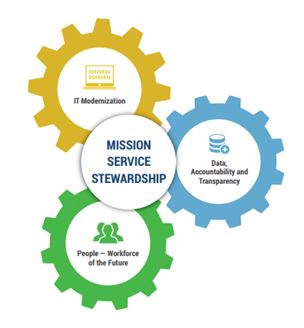
On Tuesday, President Trump released his management agenda, which focused heavily on his IT modernization goals.
Top of mind for the administration? Improving the customer experience, helping agencies better deliver on their missions, and reducing costs to the taxpayer.

“To move us from vision to action, the president’s management agenda focuses on three key drivers of transformation,” said Margaret Weichert, deputy director for management at the Office of Management and Budget, during a rollout event in Kansas City, Mo.
In the 54-page document, the White House laid out key transformation drivers: IT modernization; data, accountability, and transparency; and a workforce for the 21st century.
Driving Modernization Home
The White House touches on everything from replacing legacy systems to implementing funding provisions included in the MGT Act.
In fact, the MGT Act gets significant real estate in the agenda, with the administration positioning it as somewhat of a modernization silver bullet.
“The MGT provisions provide agencies with the authorities and technical expertise necessary to move the government closer to leading industry practices in modernization, pivot traditional bureaucratic problems towards embracing technology opportunities, and ultimately allow the Federal government to provide better, more secure, user-centered services to the American people,” the agenda explains.
The MGT Act will also play a significant role in upgrading and replacing legacy systems. Specifically, the potentially $500 million Technology Modernization Fund and agency-specific IT working capital funds can help fund the modernization efforts.
When it comes to overhauling legacy systems, the White House has its eye on the cloud. The agenda stressed the importance of implementing commercial cloud solutions, including cloud-based solutions such as email and collaboration tools.
In addition to overhauling legacy systems, the White House wants to improve the Federal government’s cybersecurity posture – and it thinks the private sector can help. The administration explains that it hopes to work the private sector to deploy cutting edge cybersecurity capabilities across the Federal government.
In the agenda, the administration calls for significant transformation and innovation across the Federal government. To help agencies fully realize the potential of IT modernization, the White House is standing up Centers of Excellence (CoE). The CoE will bring together the General Services Administration and private sector’s expertise to centralize best practices and give agencies hands-on help with implementing new technologies. The end goal is to accelerate modernization of IT infrastructure across Federal agencies. The CoE’s first project will be working with the Department of Agriculture to improve service design and the customer experience.
Making Data Useful
The White House wants agencies to view data as a strategic asset and establish data policies, roles, and responsibilities for data privacy, security, and confidentiality.
Once the government is more effectively managing its data, the administration wants to make sure the data is actually used. This means developing and procedures that incentivize “investments that enable stakeholders to effectively and efficiently access and use data assets.” Once that hurdle is crossed, the agenda calls for greater data-driven decision making. The White House envisions data improving real-time decision making, as well as retrospective evaluations or program effectiveness.
Additionally, the White House wants to increase the amount of non-sensitive data shared with the general public and researchers. The administration contends this will fuel greater research, as well as improve accountability and transparency.
Next-Gen Government Employees
“The personnel system supporting Federal employees is a relic of an earlier era that has failed to keep pace with changing workforce needs,” the agenda says. “Both employees and managers agree that the performance management system fails to reward the best and address the worst employees.”
While the administration’s diagnosis of the state of the Federal IT workforce is grim, the agenda offers up goals and initiatives to improve the situation. The administration pledges to work with Congress to realign the Federal workforce to achieve the government’s mission, align compensation with competitive labor market practices, and engage in human capital management reforms.
What does that all really mean? Essentially, the administration wants to streamline the hiring process so it can hire better people, reward top performers, and cut poor performers loose. On top of that, the agenda calls for a greater focus on agile development and improved continuous education and training programs.
The management agenda is clear in its goals and priorities. All that’s left to be seen is whether the White House–and the rest of the Federal government–can deliver on its promises.
Check back with MeriTalk in the next few days, we’ll be chatting with experts from government and the private sector for their thoughts on the agenda.
